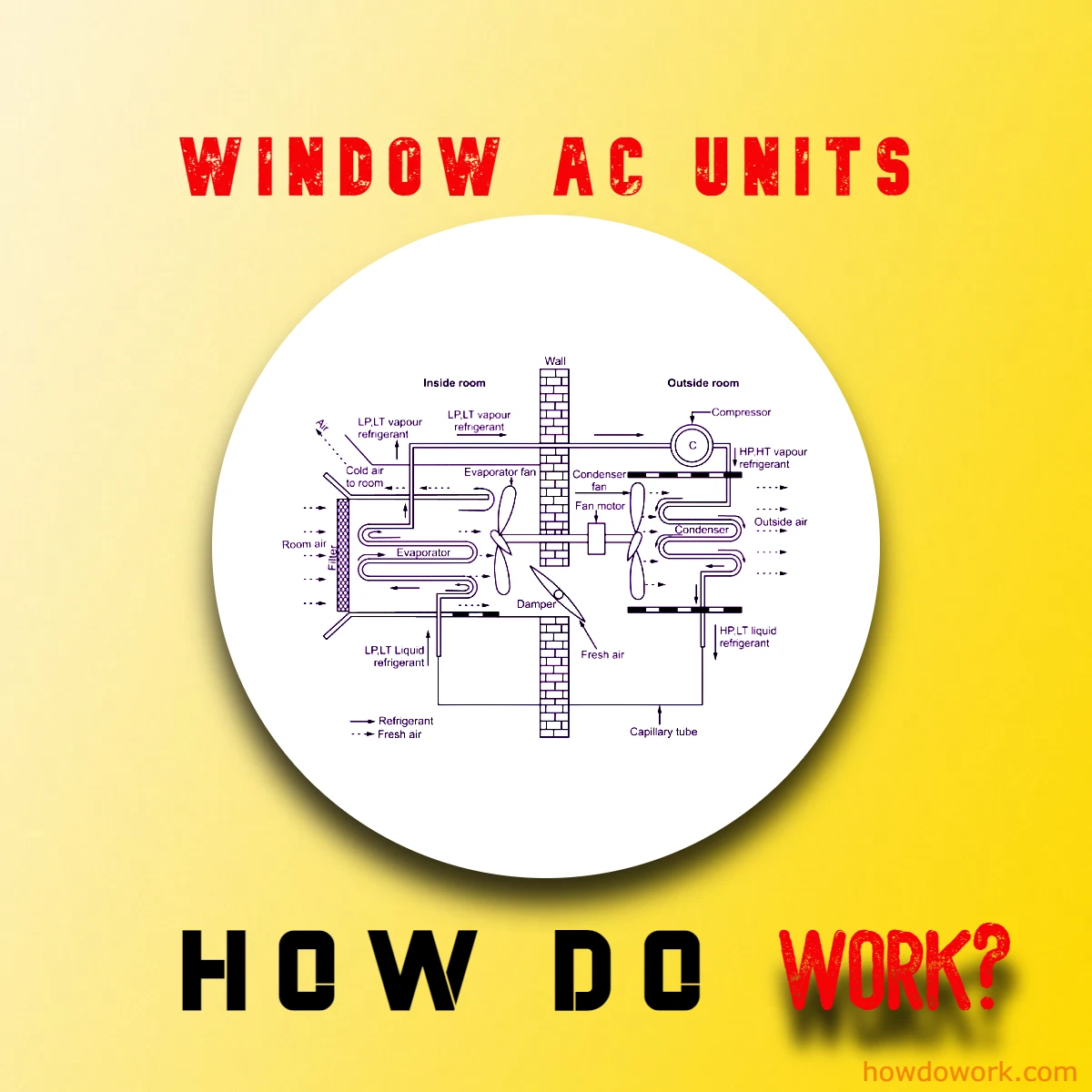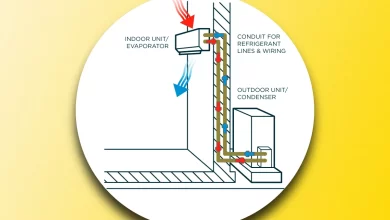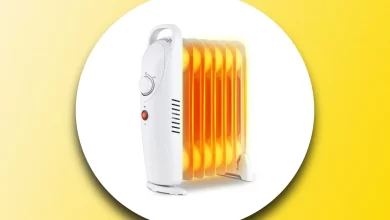
Window AC units, also known as window air conditioners, work by drawing warm indoor air into the unit through a vent, where it encounters an evaporator coil filled with cold refrigerant. As the air passes over this coil, the refrigerant absorbs the heat, effectively cooling and dehumidifying the air. The now-cooled air is then circulated back into the room by a blower fan, ensuring even temperature distribution. Simultaneously, the absorbed heat is transferred to a condenser coil located outside the unit, where it is expelled into the outdoor environment. This continuous cycle of absorbing and releasing heat, facilitated by the compressor and refrigerant, maintains a comfortable indoor temperature, making window AC units an efficient and popular choice for cooling single rooms or small spaces.
| Aspect | Central AC Units | Window AC Units |
|---|---|---|
| Installation | Requires professional installation | Can be installed as a DIY project in a window |
| Cooling Capacity | Suitable for cooling entire homes or large spaces | Designed for cooling single rooms or small areas |
| Location | Typically installed outside the building | Installed within a window or specially designed opening |
| Ductwork | Utilizes ducts to distribute cooled air | Directly cools the room it’s installed in |
| Complexity | More complex system with indoor and outdoor units | Self-contained system with all components in one unit |
| Energy Efficiency | Efficiency can vary based on system quality | Efficiency varies but can be selected based on needs |
| Cost | Generally more expensive to purchase and install | More affordable upfront cost |
| Maintenance | Requires periodic professional maintenance | Can be maintained by the user with regular cleaning |
| Cooling Flexibility | Cools the entire home, providing even cooling | Cools specific rooms, potentially creating hot spots |
| Portability | Not portable; fixed in place | Portable and can be moved between rooms if needed |
| Control Options | Centralized control for the whole house | Individual control for each unit |
| Room Isolation | Limited ability to isolate cooling to specific rooms | Provides precise control over cooling in selected areas |
| Noise Level | Typically quieter due to outdoor compressor | Noise levels can vary but are generally audible |
| Initial Investment and Operating Costs | Higher initial costs and potentially higher energy bills | Lower initial costs and more control over energy usage |
Contents
What are the window ac units work?
In the realm of climate control, the ubiquitous window air conditioning unit stands as a stalwart companion during the scorching heat of summer. As we embark on this journey to unravel the intricate mechanics of these remarkable devices, we venture into a world where comfort and convenience converge.
In this exploration, we will traverse the inner workings of window air conditioning units, dissecting the pivotal components and elucidating the elegant choreography of their operation. From the quiet hum of the blower fan to the rhythmic interplay of refrigerant cycles, every facet of these cooling marvels will be unveiled.
What is a Window AC Unit?
A window air conditioning unit, often referred to as a window AC or room air conditioner, is a self-contained cooling system designed to regulate the temperature in a specific space. These units are typically installed in windows or specially designed openings in walls, making them a popular choice for cooling single rooms or small areas.
Components of a Window AC Unit
Understanding the key components of a window AC unit is essential before delving into its operation. Here’s a brief overview:
1. Evaporator Coil
The evaporator coil, located on the inside of the unit, is responsible for absorbing heat and humidity from the indoor air.
2. Condenser Coil
The condenser coil, situated on the outside of the unit, releases the heat collected from the indoor air to the external environment.
3. Compressor
The compressor is the heart of the system, as it circulates refrigerant between the evaporator and condenser coils, facilitating the cooling process.
4. Refrigerant
Refrigerant is a special fluid that cycles through the coils, changing from a gas to a liquid and back again, absorbing and releasing heat in the process.
5. Blower Fan
The blower fan, located inside the unit, circulates air over the evaporator and condenser coils, ensuring efficient heat exchange.
Now that we have a basic understanding of the components, let’s explore the step-by-step operation of a window AC unit.
The Cooling Process
Step 1: Air Intake
Our journey through the window AC unit’s operation begins with the air intake. On a scorching summer day, the room’s warm air is drawn into the unit through a vent, often equipped with a filter. This filter serves a crucial role, removing dust, particles, and allergens from the incoming air, thereby improving indoor air quality.
Step 2: Cooling the Air
Once the warm air enters the unit, it encounters the evaporator coil, which is filled with cold refrigerant. As the air passes over the evaporator coil, the refrigerant absorbs the heat from the air. This process not only cools the air but also removes excess moisture, contributing to dehumidification.
Step 3: Circulation
The now-cooled and dehumidified air is propelled back into the room by the blower fan. This fan ensures that the conditioned air is evenly distributed, preventing hot spots and maintaining a comfortable temperature throughout the space.
Step 4: Heat Dissipation
While the indoor air is being cooled and circulated, the absorbed heat is transferred to the refrigerant. This heat-laden refrigerant is then pumped to the unit’s exterior, where the condenser coil comes into play.
Step 5: Heat Discharge
The condenser coil, located outside the window AC unit, releases the heat absorbed from the indoor air into the outdoor environment. This discharge of heat is why you feel warm air being expelled from the back of the unit when it’s running.
Step 6: Refrigerant Cycle
The refrigerant, now in a gaseous state after releasing heat, is sent back to the compressor to begin the cycle anew. This continuous circulation of refrigerant ensures a consistent cooling effect in the room.
Temperature Control and Energy Efficiency
Understanding how window AC units control temperature and optimize energy usage is crucial for efficient operation.
Temperature Control
Window AC units offer temperature control through a thermostat, allowing users to set their desired room temperature. Once the room reaches the preset temperature, the unit cycles on and off to maintain this comfort level.
Energy Efficiency
Efficiency is a key consideration when using a window AC unit. To enhance energy efficiency:
- Ensure the unit is correctly sized for the room to avoid overcooling or excessive energy consumption.
- Keep doors and windows closed to prevent warm air from entering the room.
- Regularly clean or replace the air filter to maintain optimal airflow.
- Consider models with programmable timers and energy-saving modes to further reduce energy consumption.
Additional Features and Maintenance
Additional Features
Modern window AC units come equipped with various features to enhance convenience and performance. These may include:
- Remote control for easy adjustments from a distance.
- Sleep mode, which gradually adjusts the temperature during the night for comfort and energy savings.
- Fan-only mode for air circulation without cooling.
- Energy-saving modes to minimize electricity usage.
Maintenance Tips
Proper maintenance is essential to prolong the life of your window AC unit and ensure it operates efficiently. Here are some maintenance tips:
- Clean or replace the air filter regularly.
- Clean the evaporator and condenser coils to remove dirt and debris.
- Check for refrigerant leaks and repair them promptly.
- Inspect and clean the unit’s fan blades.
- Ensure the window or installation opening is sealed properly to prevent drafts.
Installation and Maintenance
Now that you’ve chosen the right window AC unit, let’s dive into the installation and maintenance processes.
Installation Steps
Installing a window AC unit can be a DIY project if you’re comfortable with the process. Here are the general steps:
- Select the Location: Choose a window close to an electrical outlet and with proper support for the unit’s weight.
- Prepare the Window: Remove any obstacles, clean the window frame, and ensure it’s in good condition.
- Mount the Bracket: Install the mounting bracket provided with the unit to support its weight.
- Secure the Unit: Carefully place the AC unit onto the bracket, ensuring it’s level and secure.
- Seal the Gaps: Use weatherstripping or foam to seal gaps around the unit, preventing drafts and insects from entering.
- Plug It In: Connect the unit to a dedicated electrical outlet. Avoid using extension cords to prevent overheating.
Maintenance Schedule
Regular maintenance is essential to keep your window AC unit running smoothly. Here’s a maintenance schedule to follow:
- Monthly: Clean or replace the air filter.
- Bi-annually: Inspect and clean the evaporator and condenser coils.
- Annually: Check for refrigerant leaks and have a professional technician perform a thorough inspection.
By following this schedule, you can maximize the lifespan of your unit and ensure efficient operation.
Troubleshooting Common Issues
Even with proper maintenance, window AC units may encounter issues from time to time. Here are some common problems and troubleshooting tips:
Problem: Unit Not Cooling
Solution: Check if the thermostat is set to the desired temperature. Ensure the filter is clean, the coils are free of debris, and the unit is the correct size for the room. If the issue persists, it may require professional servicing.
Problem: Strange Noises
Solution: Unusual noises can indicate loose or damaged parts. Tighten screws and inspect the fan blades. If the problem persists, consult a technician.
Problem: Water Leaking
Solution: Check for clogged condensate drains or a tilted unit. Clear any blockages and ensure the unit is level to prevent water leakage.
Problem: Unit Not Turning On
Solution: Verify that the unit is properly plugged in and the circuit breaker is not tripped. If these are not the issues, consult a technician to inspect the electrical components.
Problem: Foul Odors
Solution: Foul odors can stem from a dirty air filter or mold growth. Clean or replace the filter, and if the problem persists, consider using a commercial air conditioner cleaner.
Choosing the Right Window AC Unit
Now that we’ve delved into the mechanics and operation of window AC units, let’s discuss how to choose the right one for your specific needs.
Cooling Capacity
One of the most critical factors in selecting a window AC unit is its cooling capacity, typically measured in British Thermal Units (BTUs). To determine the appropriate BTU rating for your space, consider the room’s size and insulation. Here’s a rough guideline:
- Small rooms (150-350 sq. ft.): 5,000-8,000 BTUs
- Medium rooms (350-550 sq. ft.): 8,000-12,000 BTUs
- Large rooms (550-1,200 sq. ft.): 12,000-21,000 BTUs
Choosing the right BTU rating ensures efficient cooling without overworking the unit or wasting energy.
Energy Efficiency Ratio (EER)
The Energy Efficiency Ratio (EER) is a measure of how efficiently the unit converts electrical energy into cooling power. Higher EER ratings indicate better energy efficiency. Look for units with a high EER to save on energy costs over time.
Noise Level
Consider the noise level of the window AC unit, especially if it will be installed in a bedroom or a quiet space. Look for models with low noise ratings to ensure a peaceful environment.
Installation Requirements
Before purchasing, assess your window or installation space to ensure it can accommodate the unit. Measure the window opening’s dimensions and check for any obstructions that might hinder installation.
Additional Features
Explore units with extra features that align with your preferences and needs. These can include digital displays, Wi-Fi connectivity for remote control, air purification systems, and more.
Conclusion
In this comprehensive guide, we’ve explored the inner workings of window air conditioning units, from their basic components to the intricate cooling process. We’ve also covered essential considerations for selecting the right unit, installation, maintenance, and troubleshooting common issues.
By following these guidelines and understanding how your window AC unit operates, you can ensure years of reliable cooling and comfort. So, embrace the cooling power of your window AC unit and stay refreshed during those scorching summer days!
FAQs
A window AC unit cools the air by utilizing a closed-loop refrigeration cycle. It draws warm indoor air into the unit, passing it over an evaporator coil filled with cold refrigerant. The refrigerant absorbs the heat from the incoming air, effectively cooling it. The now-cooled air is then circulated back into the room, providing a comfortable temperature.
The compressor in a window AC unit is essentially the heart of the system. It is responsible for circulating the refrigerant between the evaporator coil (inside the unit) and the condenser coil (outside the unit). This circulation of refrigerant facilitates the transfer of heat from the indoor air to the outdoor environment, enabling the cooling process.
Window AC units are designed for relatively straightforward installation and can often be installed as a DIY project. However, if you are unsure about the installation process or need to create a suitable opening in the wall, it may be advisable to seek professional installation services to ensure a proper and secure setup.
To maintain the efficiency of your window AC unit, regularly clean or replace the air filter to ensure proper airflow. Additionally, clean the evaporator and condenser coils to remove dirt and debris that can hinder heat exchange. Proper insulation around the unit’s installation opening and keeping doors and windows closed while it’s running can also contribute to energy efficiency.
If your window AC unit is not cooling effectively, first check the thermostat settings to ensure they are at the desired temperature. Ensure the air filter is clean and that the unit is the appropriate size for the room. If the issue persists, it may require professional servicing to diagnose and repair any underlying problems.
Yes, there are energy-efficient window AC units available on the market. Look for units with high Energy Efficiency Ratio (EER) ratings, which indicate better energy efficiency. Additionally, models with programmable timers and energy-saving modes can help reduce energy consumption when cooling is not needed at full capacity.
Read More:



